HC2091 Business Finance Group Assignment: Australian Markets Overview
VerifiedAdded on 2022/10/19
|21
|3832
|352
Report
AI Summary
This report provides a comprehensive analysis of the Australian financial markets, focusing on market structure, investment opportunities, and capital budgeting methods. It begins with an introduction to the Australian financial market and its structure, followed by a discussion of market sectors, regulatory bodies like ASIC and the Reserve Bank of Australia, and the influence of macroeconomic policies. The report delves into trading opportunities for investors, including the role of brokers, foreign direct investment policies, and access to financial data. It then explores capital budgeting criteria, outlining various methods like Net Present Value, Internal Rate of Return, and Payback Period, along with their advantages and disadvantages, and the methods most popular in Australia. The report further examines the bonds and equity markets in Australia, and concludes with an industry analysis to identify suitable investment opportunities. The report aims to provide a detailed overview of the Australian financial market to students of business finance.

Running head: AUSTRALIAN MARKETS
Australian Markets
Name of the Student:
Name of the University:
Author Note:
Australian Markets
Name of the Student:
Name of the University:
Author Note:
Paraphrase This Document
Need a fresh take? Get an instant paraphrase of this document with our AI Paraphraser
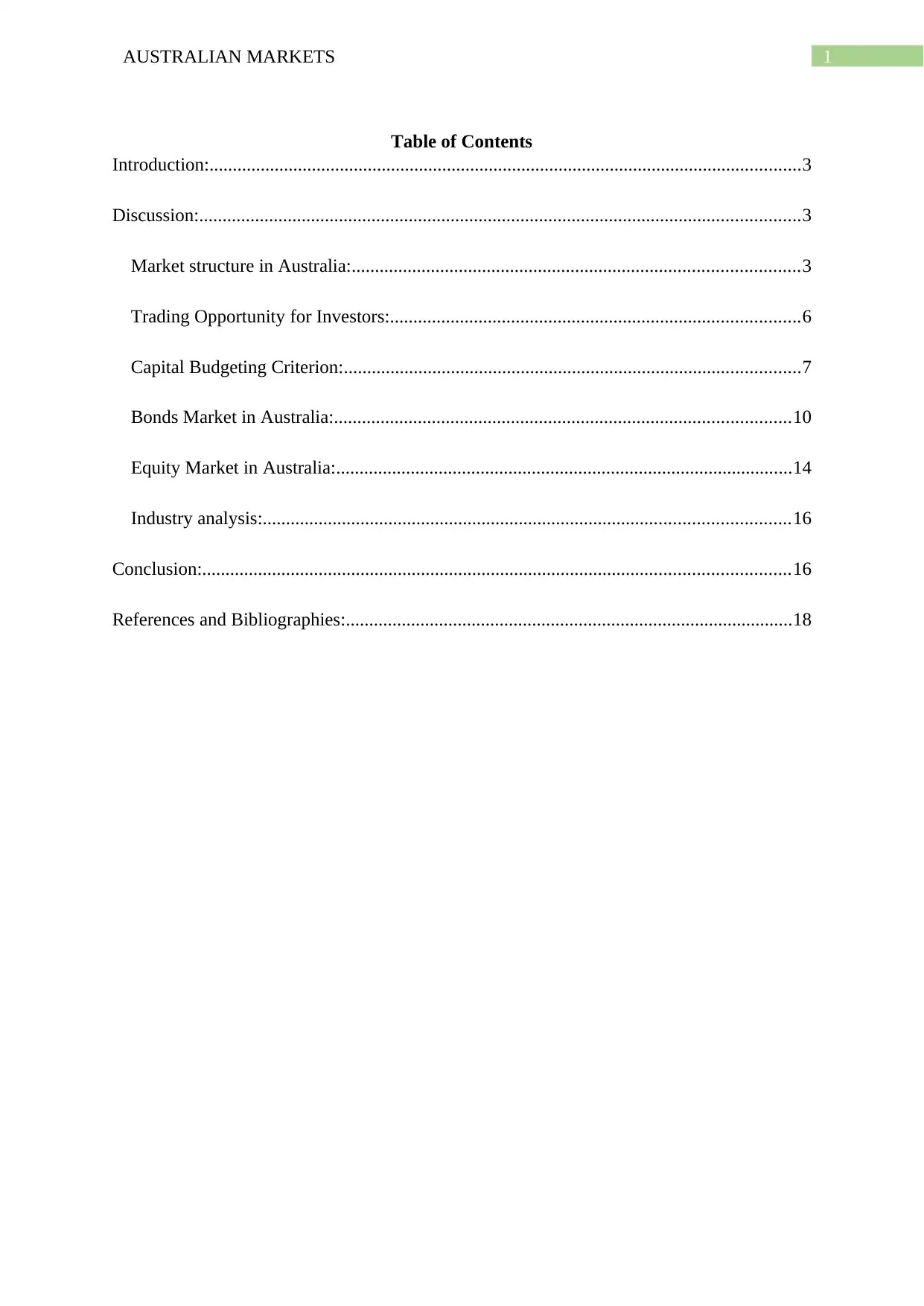
1AUSTRALIAN MARKETS
Table of Contents
Introduction:...............................................................................................................................3
Discussion:.................................................................................................................................3
Market structure in Australia:................................................................................................3
Trading Opportunity for Investors:........................................................................................6
Capital Budgeting Criterion:..................................................................................................7
Bonds Market in Australia:..................................................................................................10
Equity Market in Australia:..................................................................................................14
Industry analysis:.................................................................................................................16
Conclusion:..............................................................................................................................16
References and Bibliographies:................................................................................................18
Table of Contents
Introduction:...............................................................................................................................3
Discussion:.................................................................................................................................3
Market structure in Australia:................................................................................................3
Trading Opportunity for Investors:........................................................................................6
Capital Budgeting Criterion:..................................................................................................7
Bonds Market in Australia:..................................................................................................10
Equity Market in Australia:..................................................................................................14
Industry analysis:.................................................................................................................16
Conclusion:..............................................................................................................................16
References and Bibliographies:................................................................................................18
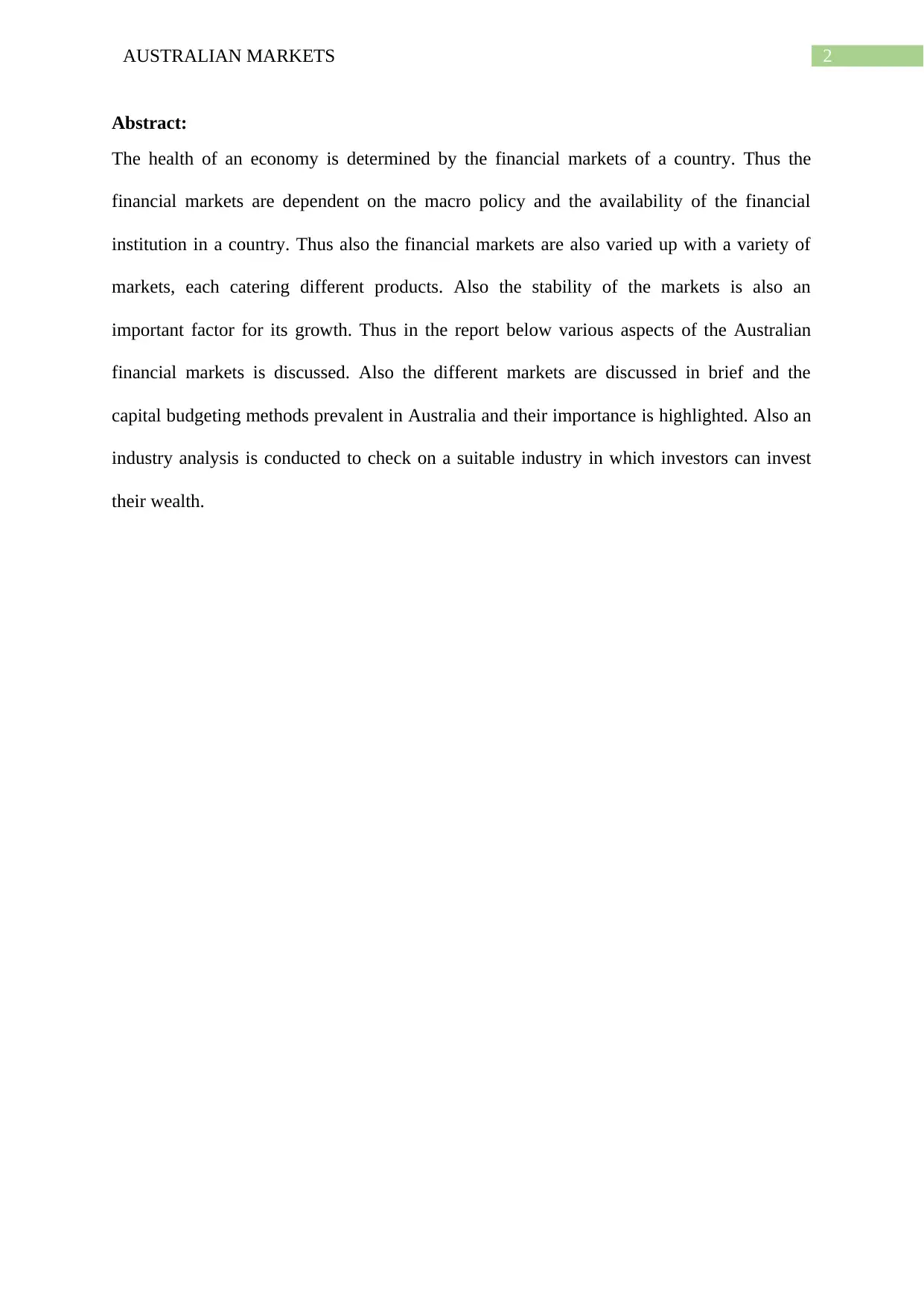
2AUSTRALIAN MARKETS
Abstract:
The health of an economy is determined by the financial markets of a country. Thus the
financial markets are dependent on the macro policy and the availability of the financial
institution in a country. Thus also the financial markets are also varied up with a variety of
markets, each catering different products. Also the stability of the markets is also an
important factor for its growth. Thus in the report below various aspects of the Australian
financial markets is discussed. Also the different markets are discussed in brief and the
capital budgeting methods prevalent in Australia and their importance is highlighted. Also an
industry analysis is conducted to check on a suitable industry in which investors can invest
their wealth.
Abstract:
The health of an economy is determined by the financial markets of a country. Thus the
financial markets are dependent on the macro policy and the availability of the financial
institution in a country. Thus also the financial markets are also varied up with a variety of
markets, each catering different products. Also the stability of the markets is also an
important factor for its growth. Thus in the report below various aspects of the Australian
financial markets is discussed. Also the different markets are discussed in brief and the
capital budgeting methods prevalent in Australia and their importance is highlighted. Also an
industry analysis is conducted to check on a suitable industry in which investors can invest
their wealth.
⊘ This is a preview!⊘
Do you want full access?
Subscribe today to unlock all pages.

Trusted by 1+ million students worldwide
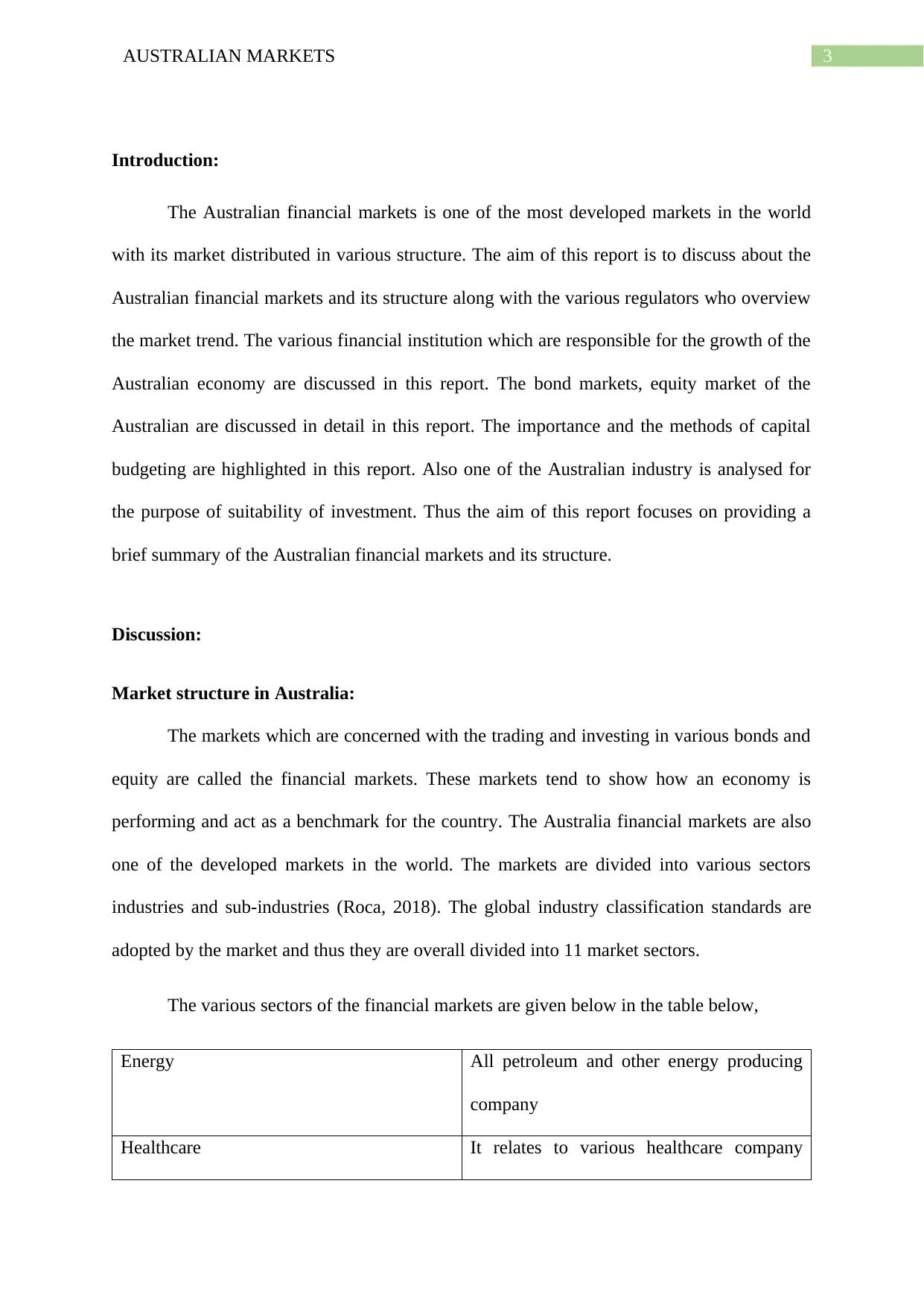
3AUSTRALIAN MARKETS
Introduction:
The Australian financial markets is one of the most developed markets in the world
with its market distributed in various structure. The aim of this report is to discuss about the
Australian financial markets and its structure along with the various regulators who overview
the market trend. The various financial institution which are responsible for the growth of the
Australian economy are discussed in this report. The bond markets, equity market of the
Australian are discussed in detail in this report. The importance and the methods of capital
budgeting are highlighted in this report. Also one of the Australian industry is analysed for
the purpose of suitability of investment. Thus the aim of this report focuses on providing a
brief summary of the Australian financial markets and its structure.
Discussion:
Market structure in Australia:
The markets which are concerned with the trading and investing in various bonds and
equity are called the financial markets. These markets tend to show how an economy is
performing and act as a benchmark for the country. The Australia financial markets are also
one of the developed markets in the world. The markets are divided into various sectors
industries and sub-industries (Roca, 2018). The global industry classification standards are
adopted by the market and thus they are overall divided into 11 market sectors.
The various sectors of the financial markets are given below in the table below,
Energy All petroleum and other energy producing
company
Healthcare It relates to various healthcare company
Introduction:
The Australian financial markets is one of the most developed markets in the world
with its market distributed in various structure. The aim of this report is to discuss about the
Australian financial markets and its structure along with the various regulators who overview
the market trend. The various financial institution which are responsible for the growth of the
Australian economy are discussed in this report. The bond markets, equity market of the
Australian are discussed in detail in this report. The importance and the methods of capital
budgeting are highlighted in this report. Also one of the Australian industry is analysed for
the purpose of suitability of investment. Thus the aim of this report focuses on providing a
brief summary of the Australian financial markets and its structure.
Discussion:
Market structure in Australia:
The markets which are concerned with the trading and investing in various bonds and
equity are called the financial markets. These markets tend to show how an economy is
performing and act as a benchmark for the country. The Australia financial markets are also
one of the developed markets in the world. The markets are divided into various sectors
industries and sub-industries (Roca, 2018). The global industry classification standards are
adopted by the market and thus they are overall divided into 11 market sectors.
The various sectors of the financial markets are given below in the table below,
Energy All petroleum and other energy producing
company
Healthcare It relates to various healthcare company
Paraphrase This Document
Need a fresh take? Get an instant paraphrase of this document with our AI Paraphraser
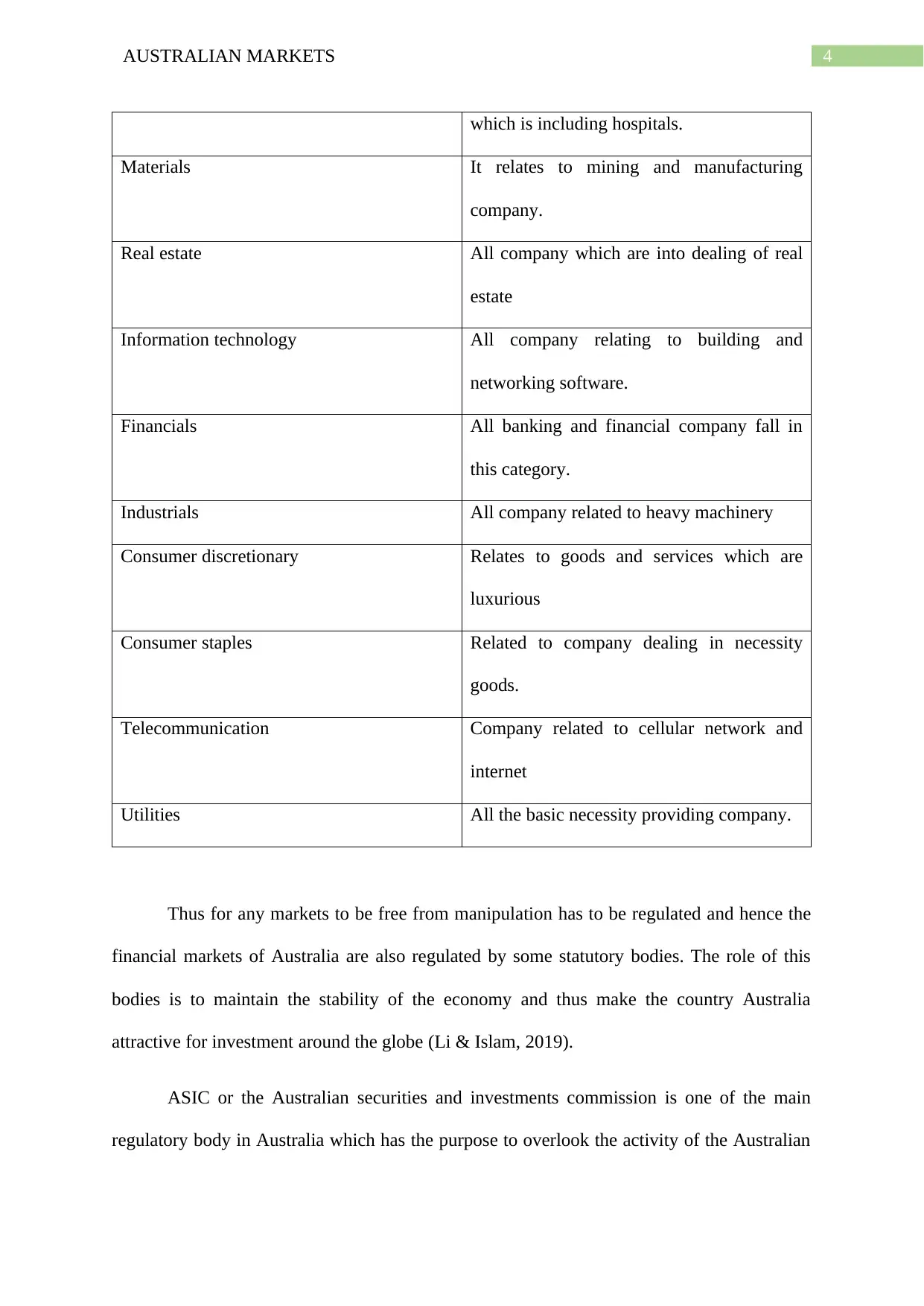
4AUSTRALIAN MARKETS
which is including hospitals.
Materials It relates to mining and manufacturing
company.
Real estate All company which are into dealing of real
estate
Information technology All company relating to building and
networking software.
Financials All banking and financial company fall in
this category.
Industrials All company related to heavy machinery
Consumer discretionary Relates to goods and services which are
luxurious
Consumer staples Related to company dealing in necessity
goods.
Telecommunication Company related to cellular network and
internet
Utilities All the basic necessity providing company.
Thus for any markets to be free from manipulation has to be regulated and hence the
financial markets of Australia are also regulated by some statutory bodies. The role of this
bodies is to maintain the stability of the economy and thus make the country Australia
attractive for investment around the globe (Li & Islam, 2019).
ASIC or the Australian securities and investments commission is one of the main
regulatory body in Australia which has the purpose to overlook the activity of the Australian
which is including hospitals.
Materials It relates to mining and manufacturing
company.
Real estate All company which are into dealing of real
estate
Information technology All company relating to building and
networking software.
Financials All banking and financial company fall in
this category.
Industrials All company related to heavy machinery
Consumer discretionary Relates to goods and services which are
luxurious
Consumer staples Related to company dealing in necessity
goods.
Telecommunication Company related to cellular network and
internet
Utilities All the basic necessity providing company.
Thus for any markets to be free from manipulation has to be regulated and hence the
financial markets of Australia are also regulated by some statutory bodies. The role of this
bodies is to maintain the stability of the economy and thus make the country Australia
attractive for investment around the globe (Li & Islam, 2019).
ASIC or the Australian securities and investments commission is one of the main
regulatory body in Australia which has the purpose to overlook the activity of the Australian
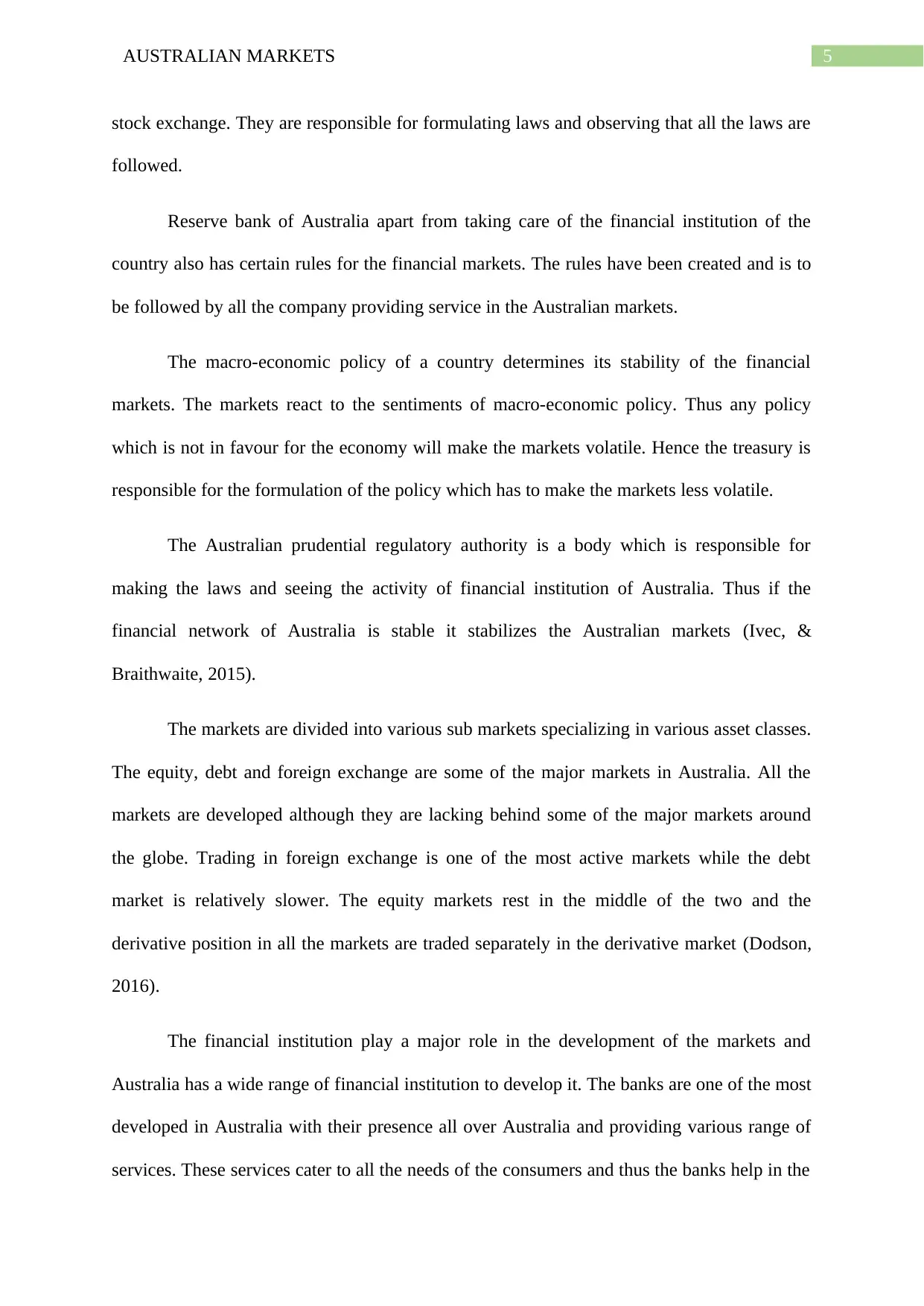
5AUSTRALIAN MARKETS
stock exchange. They are responsible for formulating laws and observing that all the laws are
followed.
Reserve bank of Australia apart from taking care of the financial institution of the
country also has certain rules for the financial markets. The rules have been created and is to
be followed by all the company providing service in the Australian markets.
The macro-economic policy of a country determines its stability of the financial
markets. The markets react to the sentiments of macro-economic policy. Thus any policy
which is not in favour for the economy will make the markets volatile. Hence the treasury is
responsible for the formulation of the policy which has to make the markets less volatile.
The Australian prudential regulatory authority is a body which is responsible for
making the laws and seeing the activity of financial institution of Australia. Thus if the
financial network of Australia is stable it stabilizes the Australian markets (Ivec, &
Braithwaite, 2015).
The markets are divided into various sub markets specializing in various asset classes.
The equity, debt and foreign exchange are some of the major markets in Australia. All the
markets are developed although they are lacking behind some of the major markets around
the globe. Trading in foreign exchange is one of the most active markets while the debt
market is relatively slower. The equity markets rest in the middle of the two and the
derivative position in all the markets are traded separately in the derivative market (Dodson,
2016).
The financial institution play a major role in the development of the markets and
Australia has a wide range of financial institution to develop it. The banks are one of the most
developed in Australia with their presence all over Australia and providing various range of
services. These services cater to all the needs of the consumers and thus the banks help in the
stock exchange. They are responsible for formulating laws and observing that all the laws are
followed.
Reserve bank of Australia apart from taking care of the financial institution of the
country also has certain rules for the financial markets. The rules have been created and is to
be followed by all the company providing service in the Australian markets.
The macro-economic policy of a country determines its stability of the financial
markets. The markets react to the sentiments of macro-economic policy. Thus any policy
which is not in favour for the economy will make the markets volatile. Hence the treasury is
responsible for the formulation of the policy which has to make the markets less volatile.
The Australian prudential regulatory authority is a body which is responsible for
making the laws and seeing the activity of financial institution of Australia. Thus if the
financial network of Australia is stable it stabilizes the Australian markets (Ivec, &
Braithwaite, 2015).
The markets are divided into various sub markets specializing in various asset classes.
The equity, debt and foreign exchange are some of the major markets in Australia. All the
markets are developed although they are lacking behind some of the major markets around
the globe. Trading in foreign exchange is one of the most active markets while the debt
market is relatively slower. The equity markets rest in the middle of the two and the
derivative position in all the markets are traded separately in the derivative market (Dodson,
2016).
The financial institution play a major role in the development of the markets and
Australia has a wide range of financial institution to develop it. The banks are one of the most
developed in Australia with their presence all over Australia and providing various range of
services. These services cater to all the needs of the consumers and thus the banks help in the
⊘ This is a preview!⊘
Do you want full access?
Subscribe today to unlock all pages.

Trusted by 1+ million students worldwide
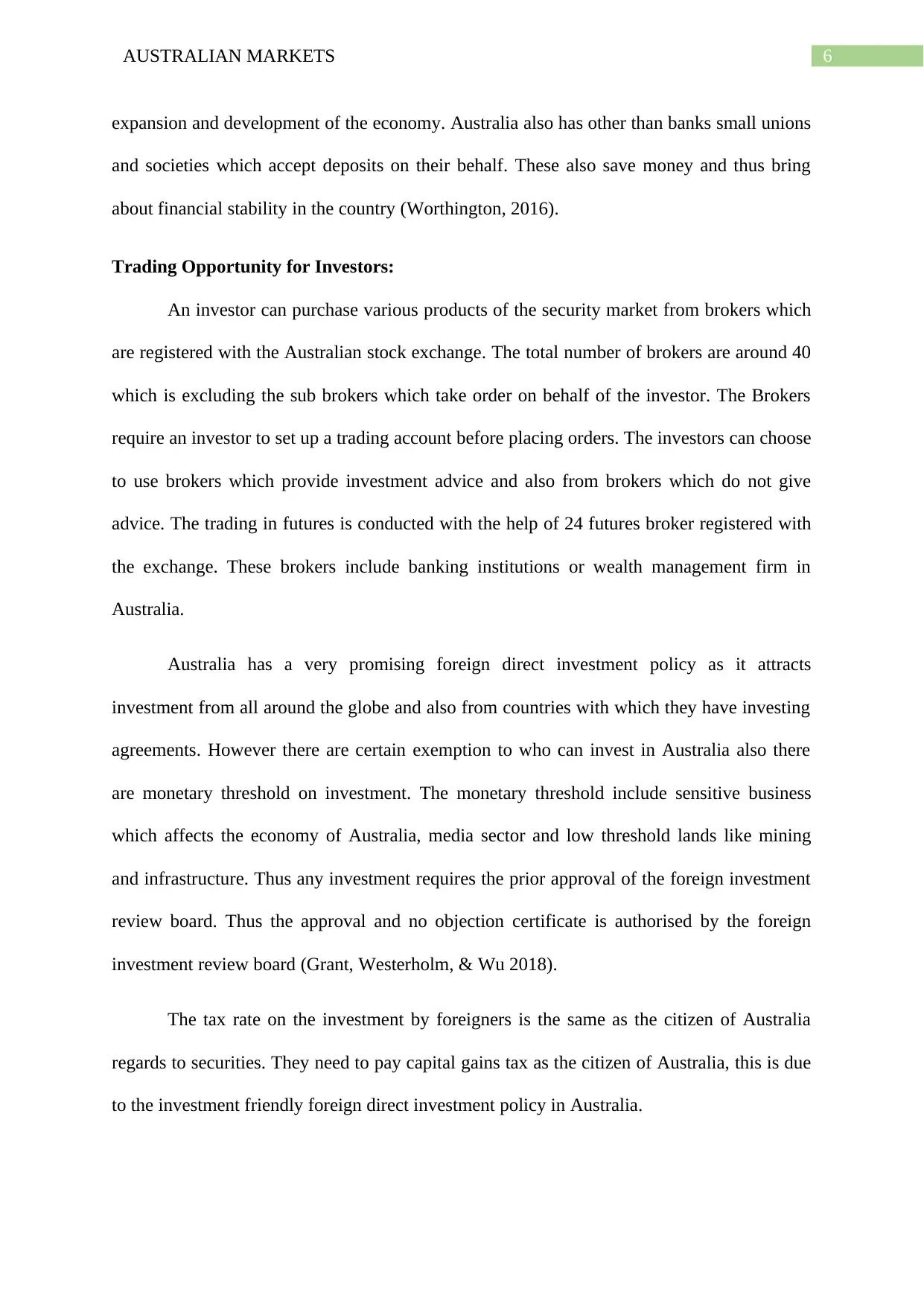
6AUSTRALIAN MARKETS
expansion and development of the economy. Australia also has other than banks small unions
and societies which accept deposits on their behalf. These also save money and thus bring
about financial stability in the country (Worthington, 2016).
Trading Opportunity for Investors:
An investor can purchase various products of the security market from brokers which
are registered with the Australian stock exchange. The total number of brokers are around 40
which is excluding the sub brokers which take order on behalf of the investor. The Brokers
require an investor to set up a trading account before placing orders. The investors can choose
to use brokers which provide investment advice and also from brokers which do not give
advice. The trading in futures is conducted with the help of 24 futures broker registered with
the exchange. These brokers include banking institutions or wealth management firm in
Australia.
Australia has a very promising foreign direct investment policy as it attracts
investment from all around the globe and also from countries with which they have investing
agreements. However there are certain exemption to who can invest in Australia also there
are monetary threshold on investment. The monetary threshold include sensitive business
which affects the economy of Australia, media sector and low threshold lands like mining
and infrastructure. Thus any investment requires the prior approval of the foreign investment
review board. Thus the approval and no objection certificate is authorised by the foreign
investment review board (Grant, Westerholm, & Wu 2018).
The tax rate on the investment by foreigners is the same as the citizen of Australia
regards to securities. They need to pay capital gains tax as the citizen of Australia, this is due
to the investment friendly foreign direct investment policy in Australia.
expansion and development of the economy. Australia also has other than banks small unions
and societies which accept deposits on their behalf. These also save money and thus bring
about financial stability in the country (Worthington, 2016).
Trading Opportunity for Investors:
An investor can purchase various products of the security market from brokers which
are registered with the Australian stock exchange. The total number of brokers are around 40
which is excluding the sub brokers which take order on behalf of the investor. The Brokers
require an investor to set up a trading account before placing orders. The investors can choose
to use brokers which provide investment advice and also from brokers which do not give
advice. The trading in futures is conducted with the help of 24 futures broker registered with
the exchange. These brokers include banking institutions or wealth management firm in
Australia.
Australia has a very promising foreign direct investment policy as it attracts
investment from all around the globe and also from countries with which they have investing
agreements. However there are certain exemption to who can invest in Australia also there
are monetary threshold on investment. The monetary threshold include sensitive business
which affects the economy of Australia, media sector and low threshold lands like mining
and infrastructure. Thus any investment requires the prior approval of the foreign investment
review board. Thus the approval and no objection certificate is authorised by the foreign
investment review board (Grant, Westerholm, & Wu 2018).
The tax rate on the investment by foreigners is the same as the citizen of Australia
regards to securities. They need to pay capital gains tax as the citizen of Australia, this is due
to the investment friendly foreign direct investment policy in Australia.
Paraphrase This Document
Need a fresh take? Get an instant paraphrase of this document with our AI Paraphraser
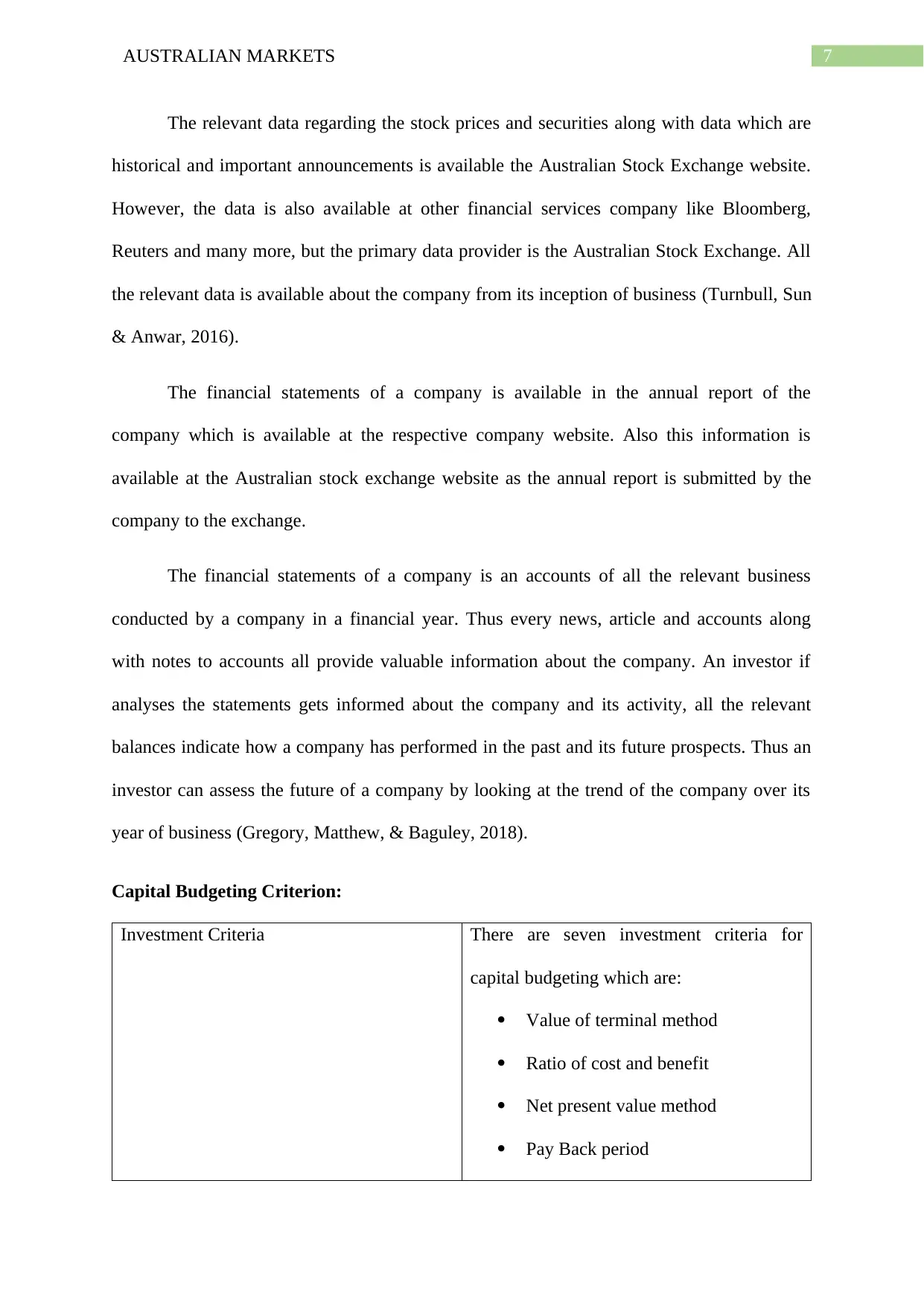
7AUSTRALIAN MARKETS
The relevant data regarding the stock prices and securities along with data which are
historical and important announcements is available the Australian Stock Exchange website.
However, the data is also available at other financial services company like Bloomberg,
Reuters and many more, but the primary data provider is the Australian Stock Exchange. All
the relevant data is available about the company from its inception of business (Turnbull, Sun
& Anwar, 2016).
The financial statements of a company is available in the annual report of the
company which is available at the respective company website. Also this information is
available at the Australian stock exchange website as the annual report is submitted by the
company to the exchange.
The financial statements of a company is an accounts of all the relevant business
conducted by a company in a financial year. Thus every news, article and accounts along
with notes to accounts all provide valuable information about the company. An investor if
analyses the statements gets informed about the company and its activity, all the relevant
balances indicate how a company has performed in the past and its future prospects. Thus an
investor can assess the future of a company by looking at the trend of the company over its
year of business (Gregory, Matthew, & Baguley, 2018).
Capital Budgeting Criterion:
Investment Criteria There are seven investment criteria for
capital budgeting which are:
Value of terminal method
Ratio of cost and benefit
Net present value method
Pay Back period
The relevant data regarding the stock prices and securities along with data which are
historical and important announcements is available the Australian Stock Exchange website.
However, the data is also available at other financial services company like Bloomberg,
Reuters and many more, but the primary data provider is the Australian Stock Exchange. All
the relevant data is available about the company from its inception of business (Turnbull, Sun
& Anwar, 2016).
The financial statements of a company is available in the annual report of the
company which is available at the respective company website. Also this information is
available at the Australian stock exchange website as the annual report is submitted by the
company to the exchange.
The financial statements of a company is an accounts of all the relevant business
conducted by a company in a financial year. Thus every news, article and accounts along
with notes to accounts all provide valuable information about the company. An investor if
analyses the statements gets informed about the company and its activity, all the relevant
balances indicate how a company has performed in the past and its future prospects. Thus an
investor can assess the future of a company by looking at the trend of the company over its
year of business (Gregory, Matthew, & Baguley, 2018).
Capital Budgeting Criterion:
Investment Criteria There are seven investment criteria for
capital budgeting which are:
Value of terminal method
Ratio of cost and benefit
Net present value method
Pay Back period
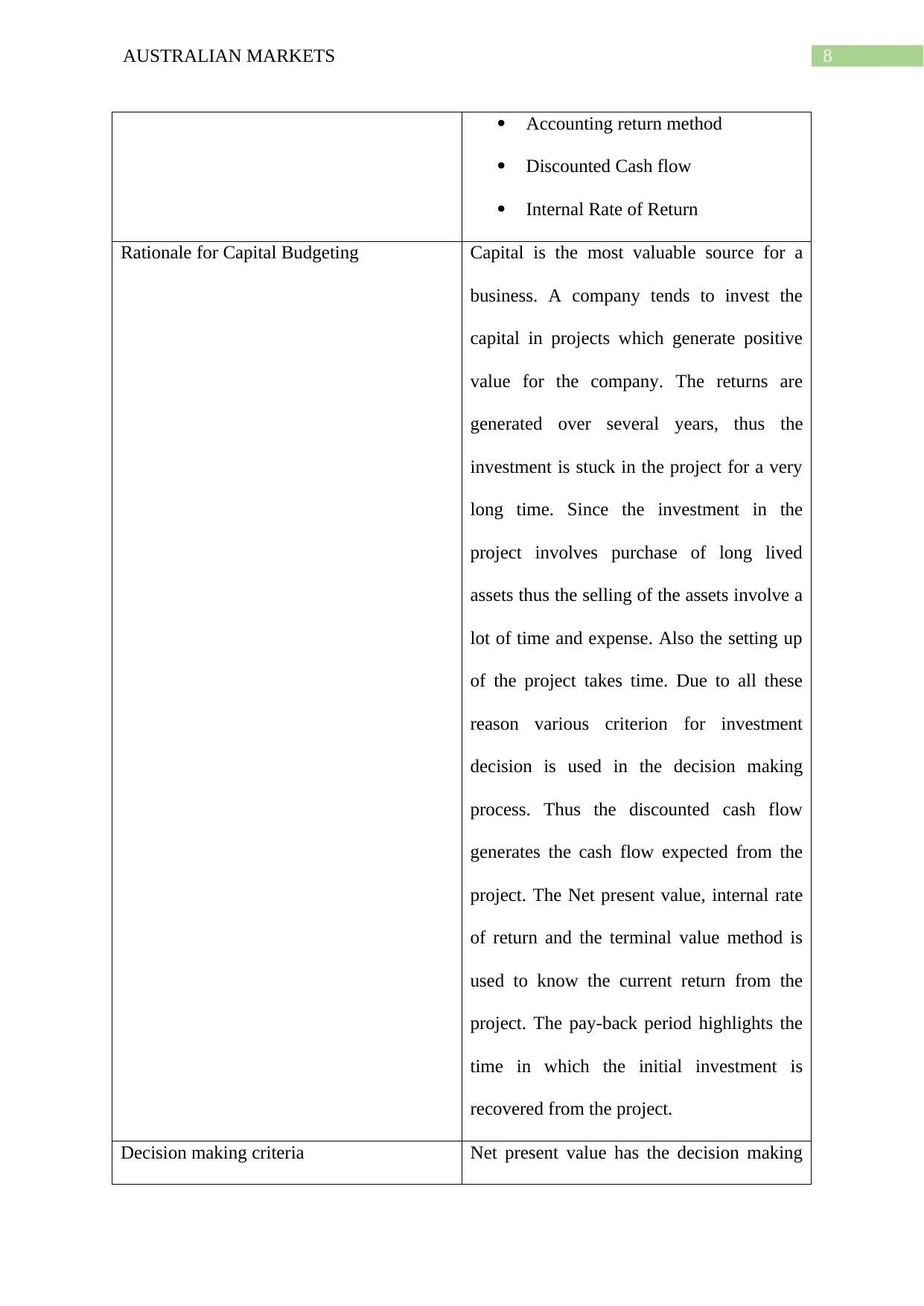
8AUSTRALIAN MARKETS
Accounting return method
Discounted Cash flow
Internal Rate of Return
Rationale for Capital Budgeting Capital is the most valuable source for a
business. A company tends to invest the
capital in projects which generate positive
value for the company. The returns are
generated over several years, thus the
investment is stuck in the project for a very
long time. Since the investment in the
project involves purchase of long lived
assets thus the selling of the assets involve a
lot of time and expense. Also the setting up
of the project takes time. Due to all these
reason various criterion for investment
decision is used in the decision making
process. Thus the discounted cash flow
generates the cash flow expected from the
project. The Net present value, internal rate
of return and the terminal value method is
used to know the current return from the
project. The pay-back period highlights the
time in which the initial investment is
recovered from the project.
Decision making criteria Net present value has the decision making
Accounting return method
Discounted Cash flow
Internal Rate of Return
Rationale for Capital Budgeting Capital is the most valuable source for a
business. A company tends to invest the
capital in projects which generate positive
value for the company. The returns are
generated over several years, thus the
investment is stuck in the project for a very
long time. Since the investment in the
project involves purchase of long lived
assets thus the selling of the assets involve a
lot of time and expense. Also the setting up
of the project takes time. Due to all these
reason various criterion for investment
decision is used in the decision making
process. Thus the discounted cash flow
generates the cash flow expected from the
project. The Net present value, internal rate
of return and the terminal value method is
used to know the current return from the
project. The pay-back period highlights the
time in which the initial investment is
recovered from the project.
Decision making criteria Net present value has the decision making
⊘ This is a preview!⊘
Do you want full access?
Subscribe today to unlock all pages.

Trusted by 1+ million students worldwide
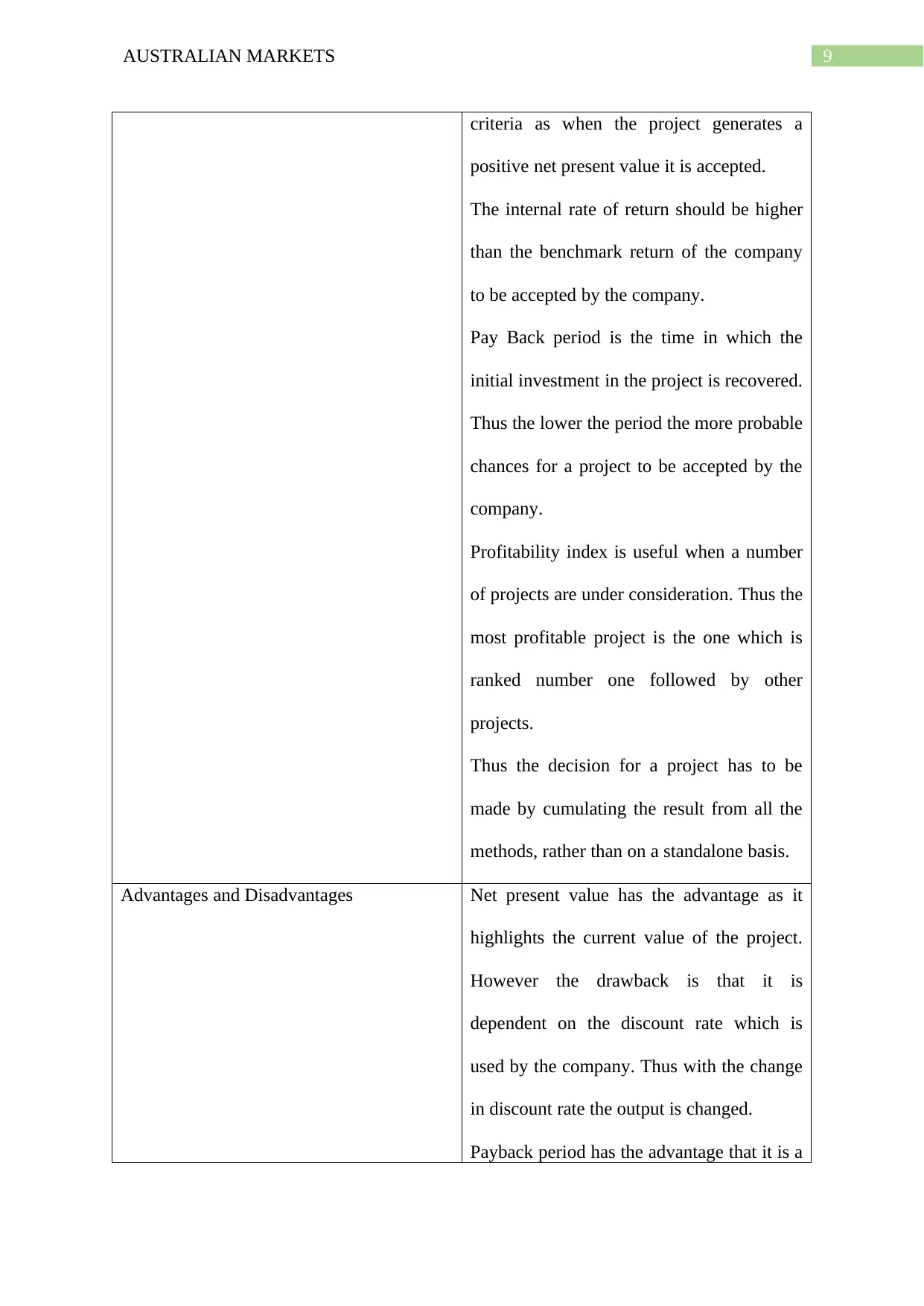
9AUSTRALIAN MARKETS
criteria as when the project generates a
positive net present value it is accepted.
The internal rate of return should be higher
than the benchmark return of the company
to be accepted by the company.
Pay Back period is the time in which the
initial investment in the project is recovered.
Thus the lower the period the more probable
chances for a project to be accepted by the
company.
Profitability index is useful when a number
of projects are under consideration. Thus the
most profitable project is the one which is
ranked number one followed by other
projects.
Thus the decision for a project has to be
made by cumulating the result from all the
methods, rather than on a standalone basis.
Advantages and Disadvantages Net present value has the advantage as it
highlights the current value of the project.
However the drawback is that it is
dependent on the discount rate which is
used by the company. Thus with the change
in discount rate the output is changed.
Payback period has the advantage that it is a
criteria as when the project generates a
positive net present value it is accepted.
The internal rate of return should be higher
than the benchmark return of the company
to be accepted by the company.
Pay Back period is the time in which the
initial investment in the project is recovered.
Thus the lower the period the more probable
chances for a project to be accepted by the
company.
Profitability index is useful when a number
of projects are under consideration. Thus the
most profitable project is the one which is
ranked number one followed by other
projects.
Thus the decision for a project has to be
made by cumulating the result from all the
methods, rather than on a standalone basis.
Advantages and Disadvantages Net present value has the advantage as it
highlights the current value of the project.
However the drawback is that it is
dependent on the discount rate which is
used by the company. Thus with the change
in discount rate the output is changed.
Payback period has the advantage that it is a
Paraphrase This Document
Need a fresh take? Get an instant paraphrase of this document with our AI Paraphraser
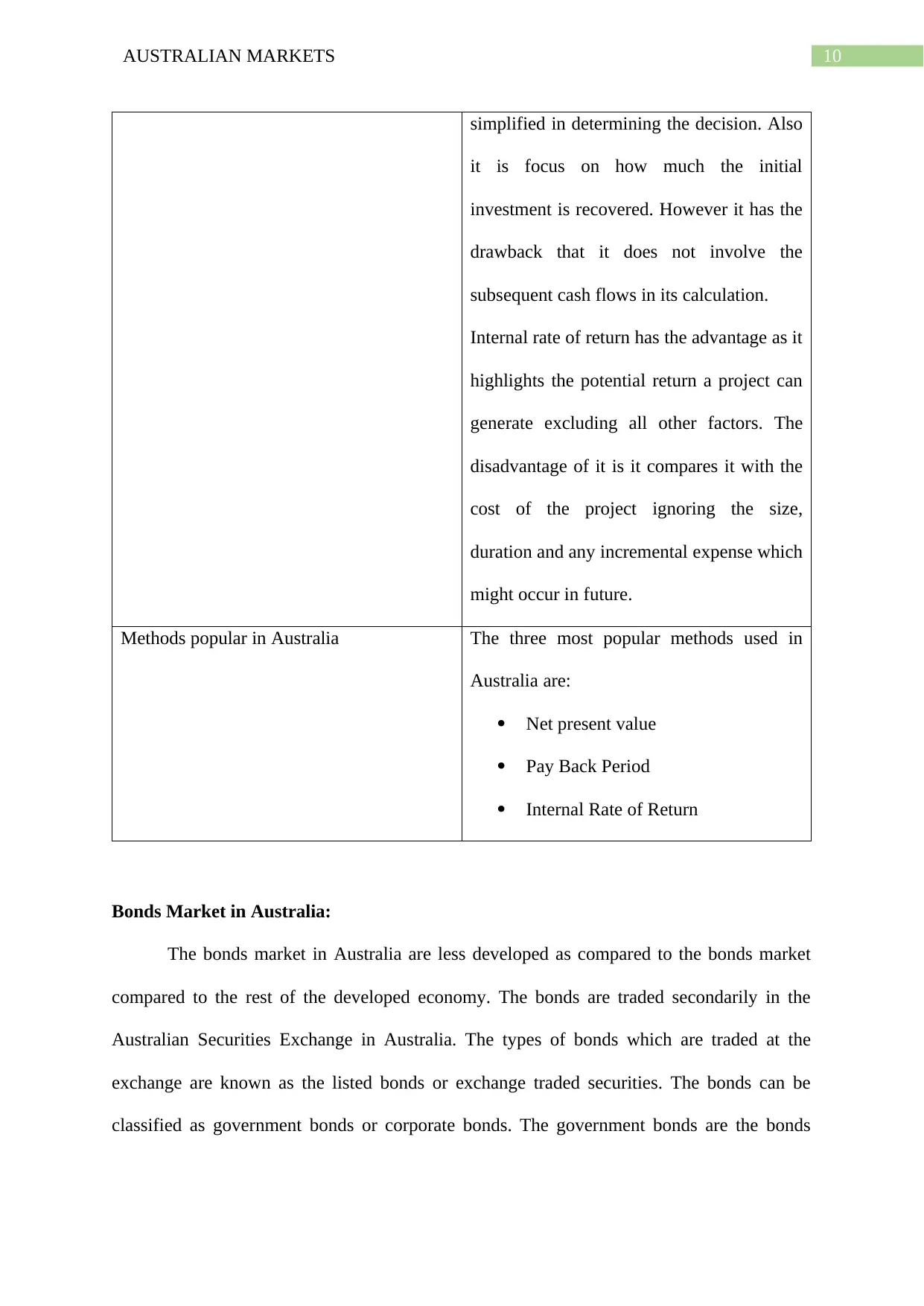
10AUSTRALIAN MARKETS
simplified in determining the decision. Also
it is focus on how much the initial
investment is recovered. However it has the
drawback that it does not involve the
subsequent cash flows in its calculation.
Internal rate of return has the advantage as it
highlights the potential return a project can
generate excluding all other factors. The
disadvantage of it is it compares it with the
cost of the project ignoring the size,
duration and any incremental expense which
might occur in future.
Methods popular in Australia The three most popular methods used in
Australia are:
Net present value
Pay Back Period
Internal Rate of Return
Bonds Market in Australia:
The bonds market in Australia are less developed as compared to the bonds market
compared to the rest of the developed economy. The bonds are traded secondarily in the
Australian Securities Exchange in Australia. The types of bonds which are traded at the
exchange are known as the listed bonds or exchange traded securities. The bonds can be
classified as government bonds or corporate bonds. The government bonds are the bonds
simplified in determining the decision. Also
it is focus on how much the initial
investment is recovered. However it has the
drawback that it does not involve the
subsequent cash flows in its calculation.
Internal rate of return has the advantage as it
highlights the potential return a project can
generate excluding all other factors. The
disadvantage of it is it compares it with the
cost of the project ignoring the size,
duration and any incremental expense which
might occur in future.
Methods popular in Australia The three most popular methods used in
Australia are:
Net present value
Pay Back Period
Internal Rate of Return
Bonds Market in Australia:
The bonds market in Australia are less developed as compared to the bonds market
compared to the rest of the developed economy. The bonds are traded secondarily in the
Australian Securities Exchange in Australia. The types of bonds which are traded at the
exchange are known as the listed bonds or exchange traded securities. The bonds can be
classified as government bonds or corporate bonds. The government bonds are the bonds
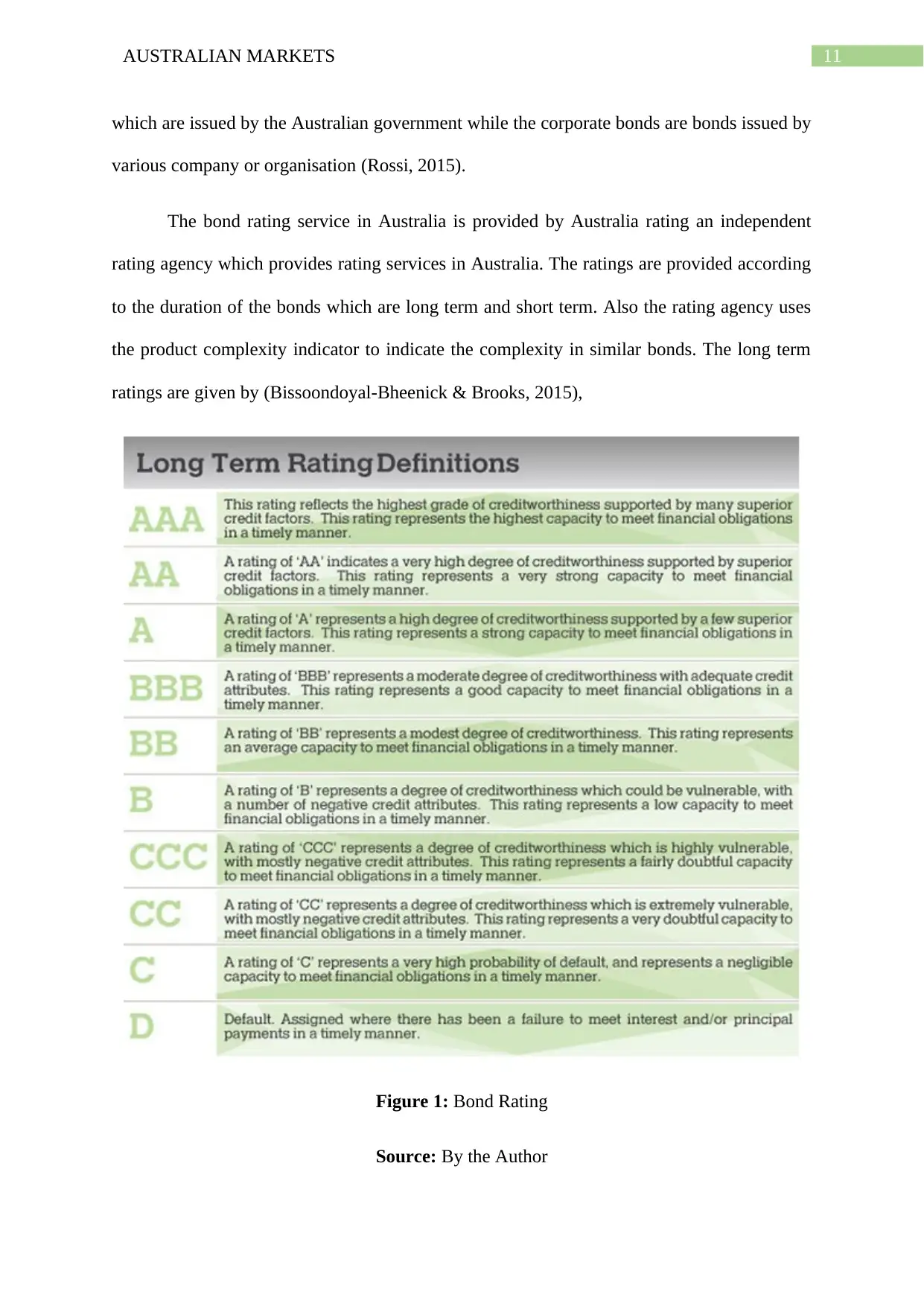
11AUSTRALIAN MARKETS
which are issued by the Australian government while the corporate bonds are bonds issued by
various company or organisation (Rossi, 2015).
The bond rating service in Australia is provided by Australia rating an independent
rating agency which provides rating services in Australia. The ratings are provided according
to the duration of the bonds which are long term and short term. Also the rating agency uses
the product complexity indicator to indicate the complexity in similar bonds. The long term
ratings are given by (Bissoondoyal-Bheenick & Brooks, 2015),
Figure 1: Bond Rating
Source: By the Author
which are issued by the Australian government while the corporate bonds are bonds issued by
various company or organisation (Rossi, 2015).
The bond rating service in Australia is provided by Australia rating an independent
rating agency which provides rating services in Australia. The ratings are provided according
to the duration of the bonds which are long term and short term. Also the rating agency uses
the product complexity indicator to indicate the complexity in similar bonds. The long term
ratings are given by (Bissoondoyal-Bheenick & Brooks, 2015),
Figure 1: Bond Rating
Source: By the Author
⊘ This is a preview!⊘
Do you want full access?
Subscribe today to unlock all pages.

Trusted by 1+ million students worldwide
1 out of 21
Related Documents
Your All-in-One AI-Powered Toolkit for Academic Success.
+13062052269
info@desklib.com
Available 24*7 on WhatsApp / Email
![[object Object]](/_next/static/media/star-bottom.7253800d.svg)
Unlock your academic potential
Copyright © 2020–2025 A2Z Services. All Rights Reserved. Developed and managed by ZUCOL.





